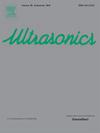Flexural mode NRUS: Theory
IF 3.8
2区 物理与天体物理
Q1 ACOUSTICS
引用次数: 0
Abstract
Nonlinear resonant ultrasound spectroscopy (NRUS) has been widely utilized for detecting substructural damage and characterizing strain-dependent properties of materials. While the longitudinal resonance of well-prepared specimens has been predominantly used, flexural and torsional resonances have also been explored recently. The objective of this paper is to provide a formal analysis of the flexural vibration of a slender beam with nonlinear hysteresis, serving as a model for a flexural mode NRUS experiment. The Davidenkov hysteresis function is employed to describe hysteretic motions, enabling the explanation of the experimentally observed nonlinear dependence of resonance frequency shifts on strain. Classical nonlinearities are also considered to obtain more general formulae for the resonance frequency shift and the increase in damping capacity with strain, which can be used to experimentally determine the hysteresis parameters. Additionally, it is shown that the classical quadratic and cubic nonlinearity parameters can be derived from NRUS experiments. The origins of strain-dependent behaviors of hysteretic nonlinear materials are clarified through the derivation of quasi-static backbone curves. Finally, the processing of transient vibration signals from impact-based nonlinear resonance experimental techniques is discussed. It is emphasized that calibrating the measured transducer signals into physical quantities (strain or acceleration signals) is crucial for obtaining absolute hysteresis parameters. It is because the signals from a nonlinear system are not scale-invariant, unlike those from a linear system.
弯曲模态NRUS:理论
非线性共振超声光谱(NRUS)已广泛应用于检测材料的子结构损伤和表征材料的应变相关特性。虽然主要使用的是精心准备的试件的纵向共振,但最近也对弯曲和扭转共振进行了探索。本文的目的是提供具有非线性迟滞的细长梁的弯曲振动的形式化分析,作为弯曲模态NRUS实验的模型。采用Davidenkov迟滞函数来描述迟滞运动,从而能够解释实验观察到的共振频移对应变的非线性依赖关系。本文还考虑了经典非线性,得到了共振频移和阻尼能力随应变增加的更一般的公式,可用于实验确定迟滞参数。此外,通过NRUS实验还可以得到经典的二次和三次非线性参数。通过准静态骨架曲线的推导,阐明了迟滞非线性材料应变依赖行为的根源。最后,讨论了基于冲击的非线性共振实验技术对瞬态振动信号的处理。强调将测量的传感器信号校准为物理量(应变或加速度信号)对于获得绝对迟滞参数至关重要。这是因为来自非线性系统的信号不像来自线性系统的信号那样是标度不变的。
本文章由计算机程序翻译,如有差异,请以英文原文为准。
求助全文
约1分钟内获得全文
求助全文
来源期刊

Ultrasonics
医学-核医学
CiteScore
7.60
自引率
19.00%
发文量
186
审稿时长
3.9 months
期刊介绍:
Ultrasonics is the only internationally established journal which covers the entire field of ultrasound research and technology and all its many applications. Ultrasonics contains a variety of sections to keep readers fully informed and up-to-date on the whole spectrum of research and development throughout the world. Ultrasonics publishes papers of exceptional quality and of relevance to both academia and industry. Manuscripts in which ultrasonics is a central issue and not simply an incidental tool or minor issue, are welcomed.
As well as top quality original research papers and review articles by world renowned experts, Ultrasonics also regularly features short communications, a calendar of forthcoming events and special issues dedicated to topical subjects.
 求助内容:
求助内容: 应助结果提醒方式:
应助结果提醒方式:


